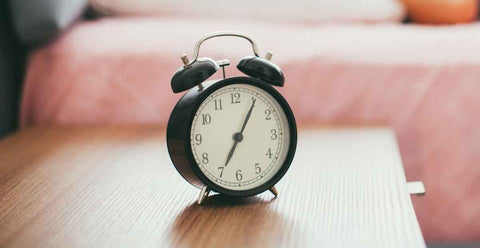How To Prep Your Little One For The End Of Daylight Savings
•
It’s the most wonderful time of the year…
The end of Daylight Savings Time for 2022!
We’re kidding, of course. Time shifts are no fun—not in either direction—for anyone, but especially for parents.
On November 6th, clocks will shift back an hour in some parts of the world—which means overnight, between November 5th and 6th you might gain one more hour.
The good news:
- In theory, you have extra hour of sleep. In practice—your children won’t give you that. But you will have one extra hour in your day, to spend how you (or your child) chooses!
- If you or your children are early risers, you’ll have more light in the morning.
The bad news:
- The sun is setting even earlier, which means less daylight in the evenings, which can mess with our circadian rhythms
- The increased darkness in the evenings can be the onset of SAD (seasonal affective disorder) for some people
- And most importantly: if you don't prepare for this, the time shift can mess up your carefully-created kids' schedules (as well as your own!)
Look, we’re parents, too. We know how much these Daylight Savings Time time shifts can be rough!
But fortunately, the sleep science experts know what to do to make the transition as seamless as possible.
Moving our clocks back one hour effectively causes a one-hour "jetlag" in our bodies. One bit of good news: doing it in the westerly direction (meaning we gain an hour) is actually easier than when we “spring ahead” in springtime. But that doesn’t mean it’s not rough on kids, and you.
But you can handle this change, for yourself and your whole family, relatively easily, by following our advice below. We've also got you covered if you are starting daylight savings. And if you are not changing times at all, understanding how the body clock works below will help you manage any sleep changes or inconsistencies.

GRADUALLY SHIFT YOUR (AND YOUR FAMILY'S) SCHEDULES
The most important thing you can do before Daylight Savings Times ends is to gradually shift your family’s entire schedule.
Here’s how:
1. Starting 5 days before the time change—Tuesday, November 2nd— put your baby or child down 20 minutes later, and go to bed 20 minutes later yourself.
2. The next morning—Wednesday November 3rd—get up 20 minutes later.
If your child refuses to comply with his new wakeup time—how shocking—simply leave him in his room or crib to play or a bit until your desired wakeup time. Crucially, don't turn on the light or open the shades.
Other tips for managing an early riser here. (And if you need help with your child’s sleep schedule, especially naps, come chat with us over on the Kulala app.)
Throughout the day, shift your other activities by that same 20-minute mark: naps, mealtimes, dinner, bath time—everything on your carefully laid-out schedule gets the same shift. (We understand schools don’t do this, so you may not be able to shift everything, but do the best you can with what you’ve got.)
That night, put your baby or child down an additional 20 minutes later, and go to bed 20 minutes later yourself.
3. Repeat the time shift on Thursday, November 4th: go to bed an additional 20 minutes later, along with your kids. Do the same with your entire schedule.
4. On Friday, November 5th you no longer need to make any changes. You're already on winter time! This day is a buffer to help your circadian rhythm get used to the new schedule.
5. On Saturday (November 6th), the clocks have changed. You're already there! Enjoy feeling in sync with the outside world, and having taken your family with you. You should have no discomfort, sleepless nights, or fatigue in the morning or evening.
But there are some other things you can do to help as well.

HELP YOUR CIRCADIAN RHYTHM REST ITSELF
Another think you can do is to make sure your body (and your kids’) is on the right circadian rhythm. Let us explain.
As we’ve talked about before, light is incredibly important when it comes to sleep. And even more so when it comes to babies’ and children’s sleep, because they are extra sensitive to light at a young age.
Here at Kulala, light is an integral part to creating your child’s sleep schedule—and that doesn’t change when the time shift happens. So there are some things you need to continue doing to optimize sleep during this transitional period—and almost all of them have to do with light.
1. Get a lot of daylight exposure. Getting outside and exposed to sunlight helps our bodies (as well as our children’s bodies) reset their internal clocks. The blue light in sunlight suppresses melatonin, telling us it’s time to wake up.
So in the week leading up to Daylight Savings Time, as well as the week following, be sure to get outside, every day! Take a morning walk—the best blue light comes through in the morning—head to the park, or just sit in your backyard or balcony to get those rays.
Cloudy day? Not a problem! The blue light in sunlight filters through the clouds most days, so even a brisk walk under the clouds will get you some of that blue light exposure your body needs. Natural light has the most effect on our circadian rhythm, so even cloudy daylight is better than artificial indoor lights.
By the way—getting outside every day is a good practice all year round. It will continue to help entrain both your internal clock, and your child’s.
2. Use blackout shades to create a dark sleep environment. The sun will be rising earlier once daylight savings time ends, so if your desired wake time is later than the sunrise, make sure your blackout shades in your child’s room (and your own) are firmly in place before the time change.
3. Turn off or dim screens before bedtime. Screens emit artificial blue light, which as we’ve explained, tells your body to wake up by suppressing melatonin. At bedtime, we want to be telling our bodies the opposite: that it’s time to go to sleep. That’s why we need to eliminate blue light from the room, and we can do this by turning off screens, or putting them on Night Mode.
4. Use only red light at bedtime. Blue light is also emitted from all artificial white and yellow lights. That’s why we advocate for the use of only red lamp lights in the bedroom while you go through your bedtime routine. You can switch out a lamp in your child’s room with a red light bulb. Or you can buy a lamp crafted specifically for promoting sleep—like the Kulala Baby Sleep Lamp!
Do all these things, and your internal clock, as well as your kids’, will be set to the right place to deal with the time shift.

PRIORITIZE SLEEP IN THE WEEK LEADING UP TO THE TIME SHIFT
This is another thing you can do to help you and your family prepare.
In an ideal world, we’d all be prioritizing sleep every day. But we know how life can get. However, when you’re preparing for a major change, especially one that impacts your sleep, it’s more important than ever that both your child’s and your own sleep is at its most optimal.
Getting good sleep before a big change like this can help you build up a “sleep bank.” Studies have found that building up “sleep banks” before short periods of reduced sleep can decrease cognitive impairment and help preserve motor skills.
So here’s how to help yourself and your children get better rest right now:
1. Reset your and your child’s circadian rhythm using the steps outlined above
2. Create the best possible sleep environment for you and your children by:
- Using light (or lack thereof) as outlined above, using blackout shades and red light
- Getting your room and your children’s room at the right temperature (ideally between 68 and 72 degrees Fahrenheit) for sleep
- Using comfortable (and age-appropriate) bedding. For you, that means a firm mattress; for your child, that probably means a sleep sack, and depending on your child’s age, maybe a light blanket. (Blankets are not recommended while children are still in cribs; use only a sleep sack until your child is old enough and has transitioned to a toddler bed.)
- Relaxing before bed. For your children, turn off screens, take a warm bath, and read a book with your red night light. For yourself, try taking a hot bath, drinking cold water, trying meditation, and turning off stimulating or upsetting content before bed (like the news)
3. Get some exercise during the day (but not too close to bedtime). Take your children outside during those morning daylight hours, or even in the afternoon, to a playground or anywhere they can run around and use up some energy.
4. Limit caffeine and alcohol, especially close to bedtime, as these can act as stimulants and disrupt sleep.
5. Eat a healthy diet. Good nutrition is tied to sleep, and studies have shown that well-balanced diets with lots of fruits and vegetables can provide the nutrients needed for better sleep. Also be sure not to eat too close to bedtime—ideally you’ll have about 3 hours between your last meal and bedtime.
6. Stick to your routines and schedules – this is even more important right now, since you’re going to be shifting it soon.
Those are all our tips for getting yourself and your famIly prepared for the end of Daylight Savings time. Is there anything you would add? Sound off on Instagram!





